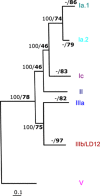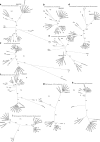Tuning fresh: radiation through rewiring of central metabolism in streamlined bacteria
- PMID: 26784354
- PMCID: PMC5029164
- DOI: 10.1038/ismej.2015.260
Tuning fresh: radiation through rewiring of central metabolism in streamlined bacteria
Abstract
Most free-living planktonic cells are streamlined and in spite of their limitations in functional flexibility, their vast populations have radiated into a wide range of aquatic habitats. Here we compared the metabolic potential of subgroups in the Alphaproteobacteria lineage SAR11 adapted to marine and freshwater habitats. Our results suggest that the successful leap from marine to freshwaters in SAR11 was accompanied by a loss of several carbon degradation pathways and a rewiring of the central metabolism. Examples for these are C1 and methylated compounds degradation pathways, the Entner-Doudouroff pathway, the glyoxylate shunt and anapleuretic carbon fixation being absent from the freshwater genomes. Evolutionary reconstructions further suggest that the metabolic modules making up these important freshwater metabolic traits were already present in the gene pool of ancestral marine SAR11 populations. The loss of the glyoxylate shunt had already occurred in the common ancestor of the freshwater subgroup and its closest marine relatives, suggesting that the adaptation to freshwater was a gradual process. Furthermore, our results indicate rapid evolution of TRAP transporters in the freshwater clade involved in the uptake of low molecular weight carboxylic acids. We propose that such gradual tuning of metabolic pathways and transporters toward locally available organic substrates is linked to the formation of subgroups within the SAR11 clade and that this process was critical for the freshwater clade to find and fix an adaptive phenotype.
Figures




References
-
- Andersson AF, Riemann L, Bertilsson S. (2009). Pyrosequencing reveals contrasting seasonal dynamics of taxa within Baltic Sea bacterioplankton communities. ISME J 4: 171–181. - PubMed
-
- Batterton J, van Baalen C. (1971). Growth responses of blue-green algae to sodium chloride concentration. Arch Microbiol 76: 151–155. - PubMed
-
- Bertilsson S, Jones JB Jr. (2003) Supply of dissolved organic matter to aquatic ecosystems: autochthonous sources. In: FindlaySEG, Sinsabaugh RL (eds), Aquatic Ecosystems: Interactivity of Dissolved Organic Matter. Academic Press: New York, NY, USA, pp 3–24.
MeSH terms
Substances
LinkOut - more resources
Full Text Sources
Other Literature Sources

